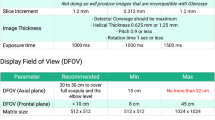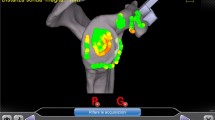Abstract
Purpose
Reverse shoulder arthroplasty (RSA) is an effective surgery for severe shoulder joint diseases. Traditionally, the preoperative planning procedure of RSA is manually conducted by experienced surgeons, resulting in prolonged operating time and unreliable drilling paths of the prosthetic fixation screws. In this study, an automatic surgical planning algorithm for RSA was proposed to compute the optimal path of screw implantation.
Methods
Firstly, a cone-shaped space containing alternative paths for each screw is generated using geometric parameters. Then, the volume constraint is applied to automatically remove inappropriate paths outside the bone boundary. Subsequently, the integral of grayscale value of the CT is used to evaluate the bone density and to compute the optimal solution. An automatic surgical planning software for RSA was also developed with the aforementioned algorithms.
Results
Twenty-four clinical cases were used for preoperative planning to evaluate the accuracy and efficiency of the system. Results demonstrated that the angles among the prosthetic fixation screws were all within constraint angle(45°), and the stability rate of the planned prosthesis was 94.92%. The average time for the automatic planning algorithm was 4.39 s, and 83.96 s for the whole procedure. Repetitive experiments were also conducted to demonstrate the robustness of our system, and the variance of the stability coefficient was 0.027%.
Conclusions
In contrast to the cumbersome manual planning of the existing methods for RSA, our method requires only simple interaction operations. It enables efficient and precise automatic preoperative planning to simulate the ideal placement of the long prosthetic screws for the long-term stability of the prosthesis. In the future, it will have great clinical application prospects in RSA.





Similar content being viewed by others
References
Best MJ, Aziz KT, Wilckens JH, McFarlnd EG, Srikumaran U (2021) Increasing incidence of primary reverse and anatomic total shoulder arthroplasty in the United States. J Shoulder Elb Surg 30:1159–1166
Aleem AW, Feeley BT, Austin LS, Ma CB, Krupp RJ, Ramsey ML, Getz CL (2017) Effect of humeral component version on outcomes in reverse shoulder arthroplasty. Orthopedics 40(3):179–186
Cox RM, Padegimas EM, Abboud JA, Getz CL, Lazarus MD, Ramsey ML, Williams GR, Horneff JG (2018) Outcomes of an anatomic total shoulder arthroplasty with a contralateral reverse total shoulder arthroplasty. J Shoulder Elb Surg 27(6):998–1003
Boyle MJ, Youn SM, Frampton CMA, Ball CM (2013) Functional outcomes of reverse shoulder arthroplasty compared with hemiarthroplasty for acute proximal humeral fractures. J Shoulder Elb Surg 22(1):32–37
Rodríguez JA, Entezari V, Iannoti JP, Ricchetti ET (2019) Pre-operative planning for reverse shoulder replacement: the surgical benefits and their clinical translation. Ann Joint 4:4
Mellano CR, Kupfer N, Thorsness R, Chalmers PN, Feldheim TF, O’Donnell P, Cole BJ, Verma NN, Romeo AA, Nicholson GP (2017) Functional results of bilateral reverse total shoulder arthroplasty. J Shoulder Elb Surg 26(9):990–996
Latif V, Denard PJ, Young AA, Liotard JP, Walch G (2012) Bilateral anatomic total shoulder arthroplasty versus reverse shoulder arthroplasty. Orthopedics 35(4):479–485
Triplet JJ, Everding NG, Levy JC, Moor MA (2015) Functional internal rotation after shoulder arthroplasty: a comparison of anatomic and reverse shoulder arthroplasty. J Shoulder Elb Surg 24(6):867–874
Wirth B, Kolling C, Schwyzer HK, Flury M, Audige L (2016) Risk of insufficient internal rotation after bilateral reverse shoulder arthroplasty: clinical and patient-reported outcome in 57 patients. J Shoulder Elb Surg 25(7):1146–1154
Boileau P, Cheval D, Gauci MO, Holzer N, Chaoui J, Walch G (2018) Automated three-dimensional measurement of glenoid version and inclination in arthritic shoulders. J Bone Joint Surg Am 100(1):57–65
Stephens SP, Paisley KC, Giveans MR, Wirth MA (2015) The effect of proximal humeral bone loss on revision reverse total shoulder arthroplasty. J Shoulder Elb Surg 24(10):1519–1526
Moreschini F, Colasanti GB, Cataldi C, Manneil L, Mondanelli N, Giannotti S (2020) Pre-operative CT-based planning integrated with intra-operative navigation in reverse shoulder arthroplasty: data acquisition and analysis protocol, and preliminary results of navigated versus conventional surgery. Dose-Response. https://doi.org/10.1177/1559325820970832
Sabesan VJ, Lima DJL, Rudraraju RT, Wilneff M, Sheth B, Yawman J (2020) Reliability and accuracy of 3D preoperative planning software for glenoid implants in total shoulder arthroplasty. Semin Arthroplasty JSES 30(4):375–382
Parsons M, Greene A, Polakovic S, Byram I, Cheung E, Jones R, Papandrea R, Youuderian A, Wright T, Flurin P, Zuckerman J (2020) Assessment of surgeon variability in preoperative planning of reverse total shoulder arthroplasty: a quantitative comparison of 49 cases planned by 9 surgeons. J Shoulder Elb Surg 29(10):2080–2088
Kim NH, Yoo SK, Lee KS (2003) Polygon reduction of 3D objects using Stokes’ theorem. Comput Methods Programs Biomed 71(3):203–210
Smithers CJ, Yooung AA, Walch G (2011) Reverse shoulder arthroplasty. Curr Rev Musculoskelet Med 4(4):183–190
Venne G, Rasquinha BJ, Pichora D, Ellis RE, Bicknell R (2015) Comparing conventional and computer-assisted surgery baseplate and screw placement in reverse shoulder arthroplasty. J Shoulder Elb Surg 24(7):1112–1119
Acknowledgements
This work was supported by grants from the National Natural Science Foundation of China (81971709; M-0019; 82011530141), the Foundation of Science and Technology Commission of Shanghai Municipality (19510712200; 20490740700), Shanghai Jiao Tong University Foundation on Medical and Technological Joint Science Research (YG2019ZDA06; YG2021ZD21; YG2021QN72; YG2022QN056), the Program of Shanghai Academic/Technology Research Leader (19XD1402800), the Shanghai Municipal Education Commission Scientific Research and Innovation Program (2021-01-07-00-02-E00082), the Clinical Research Center of Shanghai University of Medicine & Health Sciences (20MC2020003), the Academician Expert Workstation of the Jinshan District (jszjz2020007Y), the Plan of Medical Key Specialty Construction, and the Shanghai Health Committee (ZK2019B03).
Author information
Authors and Affiliations
Corresponding authors
Ethics declarations
Conflict of interest
The authors declare that they have no conflict of interest.
Ethical approval
All procedures performed in studies involving human participants were in accordance with the ethical standards of the institutional and/or national research committee and with the 1964 Helsinki Declaration and its later amendments or comparable ethical standards.
Informed consent
There was no informed consent required for the work reported in this manuscript.
Additional information
Publisher's Note
Springer Nature remains neutral with regard to jurisdictional claims in published maps and institutional affiliations.
Rights and permissions
About this article
Cite this article
Li, H., Xu, J., Zhang, D. et al. Automatic surgical planning based on bone density assessment and path integral in cone space for reverse shoulder arthroplasty. Int J CARS 17, 1017–1027 (2022). https://doi.org/10.1007/s11548-022-02633-z
Received:
Accepted:
Published:
Issue Date:
DOI: https://doi.org/10.1007/s11548-022-02633-z




